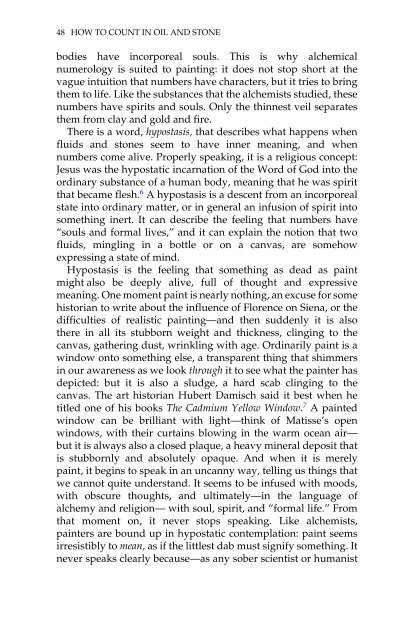What Painting Is: How to Think about Oil Painting ... - Victoria Vesna
What Painting Is: How to Think about Oil Painting ... - Victoria Vesna
What Painting Is: How to Think about Oil Painting ... - Victoria Vesna
You also want an ePaper? Increase the reach of your titles
YUMPU automatically turns print PDFs into web optimized ePapers that Google loves.
48 HOW TO COUNT IN OIL AND STONE<br />
bodies have incorporeal souls. This is why alchemical<br />
numerology is suited <strong>to</strong> painting: it does not s<strong>to</strong>p short at the<br />
vague intuition that numbers have characters, but it tries <strong>to</strong> bring<br />
them <strong>to</strong> life. Like the substances that the alchemists studied, these<br />
numbers have spirits and souls. Only the thinnest veil separates<br />
them from clay and gold and fire.<br />
There is a word, hypostasis, that describes what happens when<br />
fluids and s<strong>to</strong>nes seem <strong>to</strong> have inner meaning, and when<br />
numbers come alive. Properly speaking, it is a religious concept:<br />
Jesus was the hypostatic incarnation of the Word of God in<strong>to</strong> the<br />
ordinary substance of a human body, meaning that he was spirit<br />
that became flesh. 6 A hypostasis is a descent from an incorporeal<br />
state in<strong>to</strong> ordinary matter, or in general an infusion of spirit in<strong>to</strong><br />
something inert. It can describe the feeling that numbers have<br />
“souls and formal lives,” and it can explain the notion that two<br />
fluids, mingling in a bottle or on a canvas, are somehow<br />
expressing a state of mind.<br />
Hypostasis is the feeling that something as dead as paint<br />
might also be deeply alive, full of thought and expressive<br />
meaning. One moment paint is nearly nothing, an excuse for some<br />
his<strong>to</strong>rian <strong>to</strong> write <strong>about</strong> the influence of Florence on Siena, or the<br />
difficulties of realistic painting—and then suddenly it is also<br />
there in all its stubborn weight and thickness, clinging <strong>to</strong> the<br />
canvas, gathering dust, wrinkling with age. Ordinarily paint is a<br />
window on<strong>to</strong> something else, a transparent thing that shimmers<br />
in our awareness as we look through it <strong>to</strong> see what the painter has<br />
depicted: but it is also a sludge, a hard scab clinging <strong>to</strong> the<br />
canvas. The art his<strong>to</strong>rian Hubert Damisch said it best when he<br />
titled one of his books The Cadmium Yellow Window. 7 A painted<br />
window can be brilliant with light—think of Matisse’s open<br />
windows, with their curtains blowing in the warm ocean air—<br />
but it is always also a closed plaque, a heavy mineral deposit that<br />
is stubbornly and absolutely opaque. And when it is merely<br />
paint, it begins <strong>to</strong> speak in an uncanny way, telling us things that<br />
we cannot quite understand. It seems <strong>to</strong> be infused with moods,<br />
with obscure thoughts, and ultimately—in the language of<br />
alchemy and religion— with soul, spirit, and “formal life.” From<br />
that moment on, it never s<strong>to</strong>ps speaking. Like alchemists,<br />
painters are bound up in hypostatic contemplation: paint seems<br />
irresistibly <strong>to</strong> mean, as if the littlest dab must signify something. It<br />
never speaks clearly because—as any sober scientist or humanist


